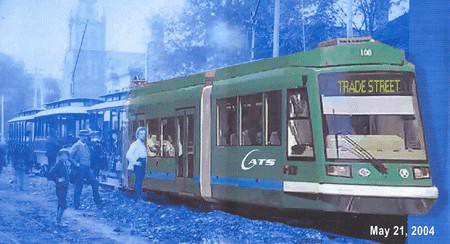 New Cranes (on the left) are still on a barge, while being transferd to join their sisters on the shore.
New Cranes (on the left) are still on a barge, while being transferd to join their sisters on the shore.The economy has crashed, and money is tight everywhere, across the American heartland, the prices of new homes are about equal to the Florida market in 1990. South Florida tourism has suffered, and the State is scrambling to make do with a tight belt. The fuel situation has caused many in the old American oil patch to go back to work for the first time since the 1980's. Things are looking better out on the rigs, but the nation is hardly beating a path to their doorstep. Here in Jacksonville we are an island of explosive growth in a sea of doom and gloom, and JaxPort is lighting that fuse.
On a once-sleepy strip of Dames Point overlooking the St. Johns River in northeast Jacksonville, crews are busy with the biggest contract in Jacksonville Port Authority history — the construction of a terminal for Tokyo-based Mitsui O.S.K. Lines, which will provide the first direct container ship service between northeast Florida and Asia.
On the land, the crews are laying rails 100 feet apart for hulking new cranes that can lift up to 50 tons of cargo at a time. In the water, dredges are scraping out a turning basin to make room for larger ships that will eventually triple Jaxport’s container capacity.
Another new terminal, for Seoul-based Hanjin, is also in the planning stages — along with a boatload of infrastructure projects. Those include an intermodal facility where containers will be transferred onto trains, and a deepening of Jaxport’s shipping channel to 45 feet — by itself at least a $400-million prospect. “The opportunities are lining up,” says Rick Ferrin, Jaxport’s executive director. “If we play them right, we’ll be one of the top 10 container ports in the country.”
While talking on the phone to my oil driller son in Oklahoma, and hearing him complain about the civic jealousy that has sent the OKC talk show hosts into a Jax-Bash routine on such subjects as "small town", "no sports", "no future", "terrible football"... And so it was as the Florida Highway Patrol closed down the Broward/Dames Point suspension bridge. Concerns over clearance gave them a 5 foot safety margin at low tide. I watched as they docked the massive cranes next to the earlier arrivals, which are already in place. Two more enter our port in October or November.
Already companies from around the world are scrambling to our door as distribution centers, warehousing and terminal facilities boom. Thousands of new jobs in the making. Not amusement park, hotel or minimum wage jobs either. This is Jacksonville, the City that works and smells like money. I was standing in miles of new pavement, as if awaiting the first of some million containers per year that will will soon arrive. I chuckled, that two or three of those containers might even find their way to some Oklahoma City Wal-Mart, perhaps a container of footballs, or Jacksonville Jaguar jerseys, I hope they can afford to buy them.
After all, it's not Oklahoma City, headed for the status of 3Rd Largest Atlantic Port, or that the world is already calling
"The Port of Gold"



























